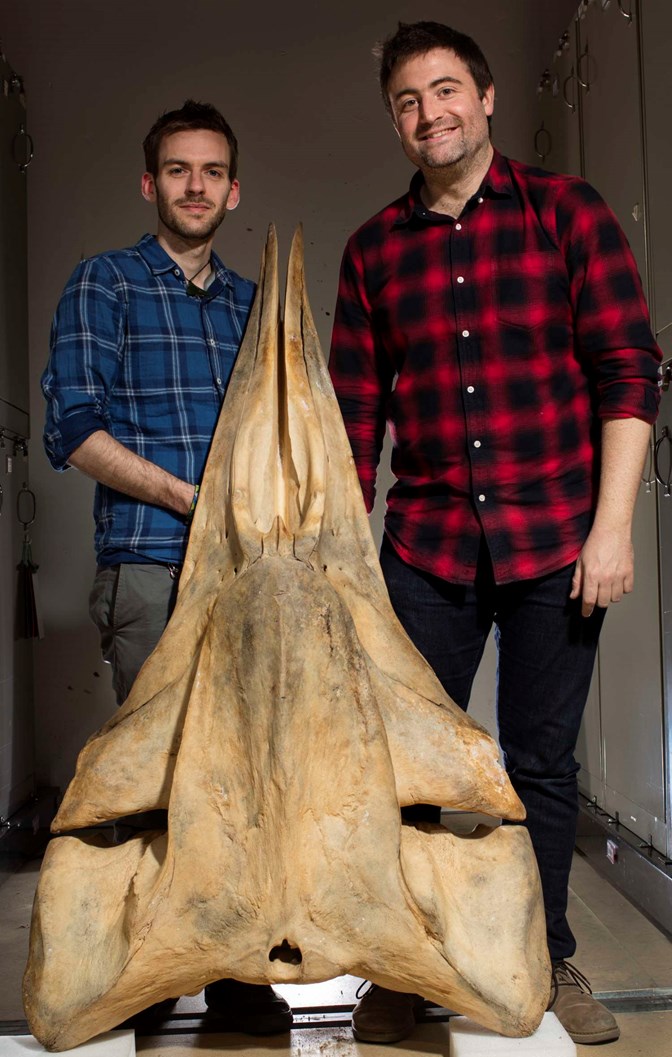Fossil finds reveal plot twist in Australian whale tale
Scientists have been astonished to discover that a whale believed to be confined to the southern hemisphere once lived off the coast of Japan and Italy.
"This is like finding a fossil kangaroo in Scotland. It is a totally unexpected discovery."Dr Erich Fitzgerald, Senior Curator of Vertebrate Palaeontology, Museums Victoria
Considered one of the most mysterious living species of whale, the pygmy right whale (Caperea marginata) is now only found in the Southern Ocean, around southern Australia, New Zealand and South America.
But fossils of pygmy right whales have just been identified in the Northern Hemisphere – in Okinawa (Japan) and Sicily (Italy).
These unexpected discoveries, published today in the prestigious scientific journal Current Biology, suggest a significant chapter in this whale’s evolutionary history took place in the Northern Hemisphere, and points to the potentially huge impact climate change could have on today’s whales.
The discovery has been made by an international team of palaeontologists from three continents including Dr Erich Fitzgerald, Senior Curator of Vertebrate Palaeontology at Museums Victoria and Dr Felix Marx, Research Associate at Museums Victoria and Monash University.
As Dr. Erich Fitzgerald said that discovery was important because of its environmental implications:
"These findings are the first to show that pygmy right whales – as endemic to southern waters as koalas are to Australia – had ancient relatives in the Northern Hemisphere. They provide new insights into how climate change has profoundly impacted the distribution of whales throughout the Earth’s oceans over millennia, and also point to how living species may be impacted by climate change, now with an added human dimension, in the future."
The pygmy right whale is the most bizarre living whale species – it is the smallest, it has strange overlapping ribs not seen in other marine mammals, and virtually nothing is known about its biology and behaviour. In effect, it’s the platypus of whales.
What we do know about its evolution has been garnered from a handful of just three fossils - including one in Museums Victoria’s collection – which are between 3 and 8 million years older than these.
The Japanese fossil, consisting of part of a skull, is between 500,000 and 1 million years old, while the Italian fossil, an ear bone, is between 1.7 and 1.9 million years old. The anatomy of these fossils is so similar to bones of the living pygmy right whale it suggests they could be the same species.
So what caused the pygmy right whale to migrate north?
The finding suggests that global cooling during the Pleistocene (The geological epoch which lasted from 2.6 million to 12,000 years ago and saw a period of repeated glaciations, commonly known as the Ice Age), which saw the growth of vast polar ice sheets in both hemispheres, forced pygmy right whales north and eventually helped them to spread across the equator. Then, as the glaciers naturally receded over millennia, the habitat of pygmy right whales once again shifted southwards, to where they live today. Warming of the climate made the equator increasingly difficult to cross, so remaining pygmy right whales in the Northern Hemisphere eventually became extinct.
Dr Felix Marx added that this points to the potential huge impact of ongoing climate change on today’s whales, "The natural changes to the Earth’s climate, now has an added human element, that may drive a reorganization of the current dispersal of whales and marine mammals. For example, a warmer world may see the pygmy right whales driven further south towards the pole."
The finding also raises the possibility of fossils of other marine fauna, such as southern walruses and northern penguins, being found in the Northern Hemisphere. However, at the moment the true extent of such occurrences is obscured by the globally poor Pleistocene fossil record.
As Dr Erich Fitzgerald explains, this unexpected finding has created even more curiosity into the story of the pygmy right whale: "These fossil finds out of left-field may be just the first step towards uncovering a much more expansive and complex evolutionary history for the pygmy right whale."
The paper ‘Northern pygmy right whales highlight Quaternary marine mammal interchange’ is authored by an international team of scientists including Erich Fitzgerald and Felix Marx, and has been published in Current Biology.
This research was supported by the Smithsonian Institution, Japan Society for the Promotion of Science, Australian Research Council and EU Marie-Sklodowska-Curie Actions.
Interviews with Erich Fitzgerald, Senior Curator of Vertebrate Palaeontology, Museums Victoria and Felix Marx, Research Associate, Museums Victoria and Monash University are available.
For interviews, a copy of the paper, high-res images and other queries please contact:








